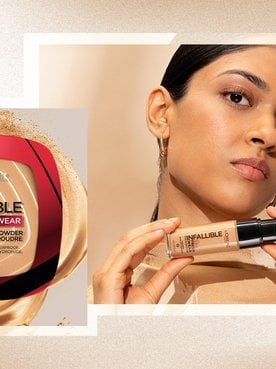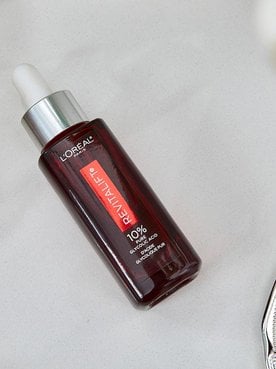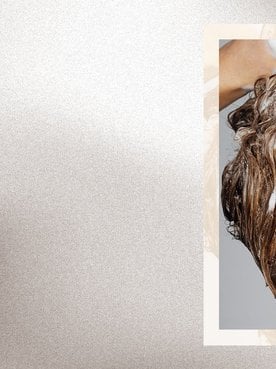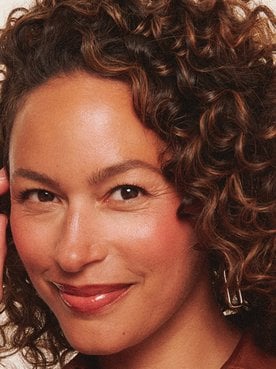Summer weather usually means extremely hot sunny days where you’d rather be sunbathing on the beach or lounging by the pool than sitting behind a computer at work. Truthfully, it doesn’t need to be summertime to take a dip into the pool or plan a beach vacation with the endless tropical spots that are sunny year-round, and various inside pools that make swimming a few laps an anytime occasion. This means you have even more opportunities to show-off your new swimsuit and enjoy some pool-time. However, this also means there are more chances for chlorine and saltwater to dehydrate your hair.
Both saltwater and chlorine can damage the hair by drying it out, which is an ultimate no-no for already brittle hair. This doesn’t mean you have to skip out on this summertime activity. Instead, improve your hair care regimen and adopt a pre-and post-pool routine that will protect hair when swimming. Keep reading for the expert-backed best tips and products for hair protection from chlorine.
Featured Products
What Does Chlorine Do to Your Hair
Chlorine strips the natural oils in your hair the same way a lot of chemical-based salon treatments do, simply because chlorine is also a chemical, confirms the CDC. The longer and more frequently your hair soaks in chlorine the more damage you’re doing to the scalp and individual hair strands. All hair types can experience dry, weakened hair that leads to split ends and hair breakage. However, hair types that are more susceptible to damage and breakage — like coily and curly hair — should be cautious of pool water as the added chlorine can cause extreme dryness to hair.
According to Jonathan Colombini, celebrity hairstylist and L’Oréal Paris Creative Director of Style and Color, if you have color-treated or chemically-treated hair, chlorine and saltwater can be harmful to your strands. Hair can be damaged by both water types, with the harshness from chlorine causing hair color discoloration and saltwater severely dehydrating the scalp, confirms Colombini. Additionally, if you have blonde hair, a dip in chlorinated water could change its color with some people reporting tinges of green showing up in their strands post swim.
How Do You Get Chlorine Out of Your Hair?
The CDC has specific guidelines for chlorinated pools to make sure the added chemical isn’t causing too much damage to the skin, hair and overall body. This means it’s relatively easy to get chlorine out of your hair — it’s the damage to hair after the fact that can be difficult to repair.
The best way to get chlorine out of your hair is to immediately rinse strands with water following a swim. You want to make sure your hair is free of chlorine so the chemical doesn’t linger. Give hair a good rinse before washing your strands with a sulfate-free shampoo that will add moisture to dry hair.
If your strands are already on the damaged side try a bond-repairing shampoo and conditioner like the L’Oréal Paris Sulfate Free Bond Repair Shampoo with Citric Acid and L’Oréal Paris Sulfate Free Bond Repair Conditioner with Citric Acid, which cleanses and conditions damaged hair with the added citric acid that rebuilds weak hair bonds. The results are smoother, stronger hair.
How to Protect Your Hair from Chlorine Damage
Regardless of your hair type you should take precautions before swimming a few laps around the pool, especially if you want to keep having healthy hair. Read more on what exactly you need to do to limit chlorine damage with insight from an expert.
Use a Swim Cap
Probably the most efficient and obvious way to protect your hair at the beach and pool is by using a swim cap. According to the American Academy of Dermatology, wearing a tight-fitting swim cap before entering the pool can shield your hair from the damaging effects of chlorine. Saltwater can also dry out the hair and scalp, so next time you go to the beach pack an extra cap alongside your broad spectrum SPF and beach towels.
Rinse Hair Before and After
One of the main things you can do to protect your hair from chlorine is to soak your hair with water before you even get into the pool, says Colombini. “My advice is to wet your hair in a shower first — this way your hair has absorbed the shower water and not the chlorine,” he says. Once your dip in the pool is done, take a trip to the showers to thoroughly rinse the chlorine or saltwater from your hair before continuing with a sulfate-free shampoo. More on that below.
Keep Hair Hydrated
The result of a long swim or pool party hangout is extremely dry hair that lacks the moisture it needs to keep a dry scalp, hair breakage and split ends at bay. To combat this damage, it’s important to hydrate before and after pool time.
Before the Pool
The CDC urges pool swimmers to thoroughly clean their hair and body before diving into a chlorinated pool as skin care and hair care products can mix hazardously with chlorine. This doesn’t mean you have to skip pre-pool hydration, instead use a bonding pre-shampoo treatment like the L’Oréal Paris EverPure Bond Strengthening Pre-Shampoo Treatment. Since you should be wetting your strands before the pool anyways, take it an extra step by applying this concentrated wash-out treatment that penetrates damaged hair with citric acid to repair weak hair bonds.
After the Pool
As we already mentioned, after exiting the pool you should immediately rinse the chlorine from your hair. Rinse your hair thoroughly before following up with a hydrating shampoo and conditioner like the L’Oréal Paris Elvive Hyaluron Plump Hydrating Shampoo, Paraben-Free and L’Oréal Paris Elvive Hyaluron Plump Hydrating Conditioner, Paraben-Free, which both contain hyaluronic acid to deeply hydrate dry, dehydrated hair. When used together, they deliver long-lasting moisture while reviving limp hair for up to 72 hours. For an extra boost of hydration, add the L’Oréal Paris Elvive Hyaluron Plump Moisture Plump Serum, Paraben-Free to your routine. This no-rinse spray is also formulated with hyaluronic acid to make dull hair look shiny and lively.
Editors tip: Embrace your kitchen pantry and reach for some coconut oil which can help chlorinated hair. Apply a small amount of coconut oil to the hair to protect strands against chlorine damage. Studies show that coconut oil has been scientifically proven to reduce protein loss for both undamaged and damaged hair when used as a pre-wash and post-wash hair treatment.
Is Chlorine Damage to Hair Permanent?
While there isn’t a lot of research behind pool chlorine causing permanent hair damage, experts like Colombini confirm that chlorine will dry out strands severely. As with any type of hair damage, through the use of dedicated hair products and the occasional hair trim, you can restore health to your strands. Your hair shouldn’t be holding you back from having fun in the pool or swimming a few laps, and when following the above precautions and post-swim treatments, chlorine damage to hair is manageable.
Next: 7 Ways to Protect Hair from Sun Damage During Summer
Photographer: Chaunte Vaughn, Senior Art Director: Melissa San Vicente-Landestoy, Associate Creative Producer: Becca Solovay, Makeup Artist: Jonet Williamson, Hair Stylist: Akihisa Yamaguchi, Wardrobe Stylist: Adriana Perez-Bell, Digital Tech: Paul Yem, Model: Chelsea Vaughn







